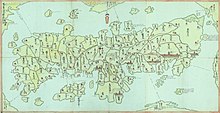Mineyama Domain (Tango): Difference between revisions
Content deleted Content added
Rescuing 1 sources and tagging 0 as dead.) #IABot (v2.0 |
Importing Wikidata short description: "Japanese feudal domain located in Tango Province" (Shortdesc helper) |
||
| Line 1: | Line 1: | ||
{{short description|Japanese feudal domain located in Tango Province}} |
|||
{{nihongo|'''Mineyama Domain'''|峯山藩|Mineyama han}} was a Japanese [[Han (Japan)|domain]] of the [[Edo period]]. It was associated with [[Tango Province]] in modern-day [[Kyoto Prefecture]].<ref name="explorer">[http://www.japanese-castle-explorer.com/province.html?name=Echigo "Echigo Province" at JapaneseCastleExplorer.com]; retrieved 2013-4-8.</ref> |
{{nihongo|'''Mineyama Domain'''|峯山藩|Mineyama han}} was a Japanese [[Han (Japan)|domain]] of the [[Edo period]]. It was associated with [[Tango Province]] in modern-day [[Kyoto Prefecture]].<ref name="explorer">[http://www.japanese-castle-explorer.com/province.html?name=Echigo "Echigo Province" at JapaneseCastleExplorer.com]; retrieved 2013-4-8.</ref> |
||
Revision as of 12:59, 27 September 2020
Mineyama Domain (峯山藩, Mineyama han) was a Japanese domain of the Edo period. It was associated with Tango Province in modern-day Kyoto Prefecture.[1]
In the han system, Mineyama was a political and economic abstraction based on periodic cadastral surveys and projected agricultural yields.[2] In other words, the domain was defined in terms of kokudaka, not land area.[3] This was different from the feudalism of the West.
List of daimyōs
The hereditary daimyōs were head of the clan and head of the domain.
 Kyōgoku clan, 1620–1868 (tozama; 10,000 koku)[4]
Kyōgoku clan, 1620–1868 (tozama; 10,000 koku)[4]
- Takamichi (1603–1665)[4]
- Takatomo (高供)
- Takaaki
- Takayuki
- Takanaga
- Takahisa
- Takamasa
- Takamasu
- Takatsune
- Takakage
- Takatomi
- Takanobu
See also
References

- ^ "Echigo Province" at JapaneseCastleExplorer.com; retrieved 2013-4-8.
- ^ Mass, Jeffrey P. and William B. Hauser. (1987). The Bakufu in Japanese History, p. 150.
- ^ Elison, George and Bardwell L. Smith (1987). Warlords, Artists, & Commoners: Japan in the Sixteenth Century, p. 18.
- ^ a b Papinot, Jacques Edmond Joseph. (1906). Dictionnaire d'histoire et de géographie du Japon; Papinot, (2003). "Kyōgoku" at Nobiliare du Japon, p. 28; retrieved 2013-4-8.
External links
- "Mineyama" at Edo 300 (in Japanese)
